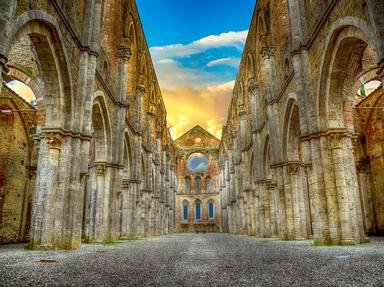Quiz Answer Key and Fun Facts
1. Gaetano Donizetti named an opera he completed in 1836, after one of the most successful Byzantine generals. This general was born in 504 and died in 565. He conquered North Africa and much of Italy (including Ravenna). Who was this general, employed by Emperor Justinianus I?
2. In 1864 Auguste Mermet completed an opera about one of Charlemagne's bravest vassals. While the main army retreated, this vassal guarded a mountain pass near the Spanish city Roncevalles. When the Muslim army attacked, he only blew his horn to call for help as soon as he was seriously wounded. Charlemagne returned to chase away the Muslim army, but his brave vassal succumbed before Charlemagne's arrival.
Who was this much commemorated vassal?
3. The Italian composer Vincenzo Manfredini created in 1763 an opera named after one of the most powerful monarchs of the 8th century. This Frankish sovereign was crowned Emperor in Rome on Christmas Day, 800. Who was this emperor, who died in 814?
4. Albert Grisar composed an opera by the name of "L'an mil" ("The Year One Thousand") in 1837. A few medieval people were unnerved by the approach of a certain year, but it wasn't the year 1000. Which year was it then that frightened them?
5. Gian Francesco Malipiero named an opera after an Italian city where the German Emperor Henry IV and Pope Gregory VII met. This episode in the Investiture Controversy symbolised the submission of worldly powers to religious powers. It became almost proverbial. What was this city in northern Italy that gave its name to Malipiero's opera of 1914?
6. 1911 saw the first night of Mascagni's opera "Isabeau". This opera tells the story of a historical person who protested in an original way against high taxation. By what name do we know the main character of this opera?
7. One of Giuseppe Verdi's early operas has the First Crusade as its historical setting. Which tribe did Verdi name his 1843 opera after?
8. In 1885, Jules Massenet completed an opera named after Rodrigo Diaz de Vivar. This Spanish nobleman is better known by the nickname the Moors gave to him. What is this nickname, which is also the title of Massenet's opera? You may answer in French or in Spanish (the orthography differs only very slightly).
9. Nicholas Bochsa composed in 1814 an opera about a certain Alfonso I. He ruled one of the Spanish kingdoms around 1100. Which kingdom was it?
10. Henry Litolff completed in 1872 an opera named after a famous medieval pair of lovers. The male partner was a forty-year-old teacher of theology. The woman he fell in love with was one of his most brilliant students, about twenty years old. She became pregnant by him and gave birth to a son called Astrolabe. When her uncle found out about the love affair, he had the culprit castrated. Who are the names of these lovers?
11. Jean-Claude Gillier composed in 1731 an opera about the first king of Sicily. In 1130, Roger II united the island of Sicily with the Duchy of Apulia and the region of Campania. To which people did Roger's ancestors belong?
12. The year 1958 saw the first night of Pizzetti's opera "Assassinio nella Cattedrale" ("Murder in the Cathedral"). Who was killed in 1170 at the Canterbury Cathedral?
13. One of Verdi's more obscure operas is named after a battlefield near Milan, where the German Emperor Frederick I Barbarossa was defeated in 1176 by the League of Lombardy. This opera (created in 1849) bears the title of "La Battaglia di _____________" ("The Battle of ___________"). Fill in the name of the battlefield.
14. In 1823, Carl Maria von Weber named an opera "Euryanthe" after Euryanthe of Savoye.
According to an ancient French story, she was betrothed to Adolar, the Count of Nevers, but Lysiart, Count of Forest fell in love with her. The opera is set somewhere between 1108 and 1137. Who was at that time the French King? One of the secondary characters in the opera is this French King.
15. André Grétry completed in 1784 an opera named after an English king who took part in the Third Crusade. Who was this king?
Source: Author
JanIQ
This quiz was reviewed by FunTrivia editor
bloomsby before going online.
Any errors found in FunTrivia content are routinely corrected through our feedback system.
